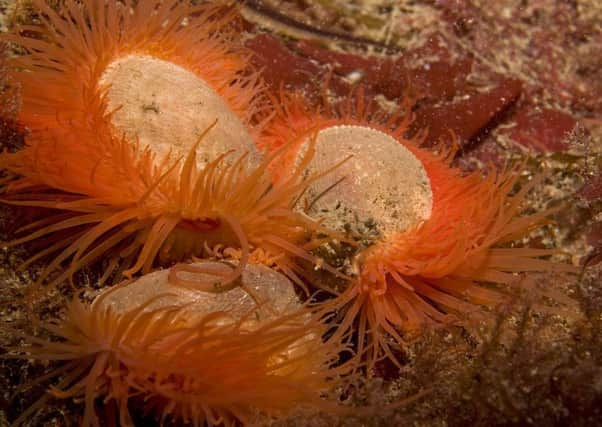Rare reef at Loch Carron devastated by scallop dredging


The seabed at the Loch Carron reef near Plockton in the Highlands has been badly damaged by a commercial dredger and it may take years, if not decades, for marine life to recover, conservationists said.
The Scottish Government said the reports are “worrying” and that an investigation will be carried out.
Advertisement
Hide AdAdvertisement
Hide AdFlame shells - bivalve molluscs with a fringe of orange tentacles - build nests from shells, stones and other materials, and live completely hidden inside them on the seabed.
Hundreds of nests can combine to make a dense bed, which supports myriad other species, including young fish and scallop spat.
Flame shell beds are vulnerable to mechanical disturbance, particularly from bottom trawls and dredges, and extensive beds are now rare, according to Scottish Natural Heritage (SNH).
Conservation charity the National Trust for Scotland (NTS) has expressed shock at the damage.
Dr Richard Luxmoore, NTS senior nature conservation adviser said: “They (flame shells) protect their nests under a fragile roof of bits of shell and other material held together with fine byssus threads.
“Ripping through this with the heavy metal teeth of a scallop dredge is like dropping a bunker-busting bomb on a nursery school. The destruction is just appalling.
“Two years ago, the Scottish Government commissioned an economic study of the impacts of fishing in the inshore zone which concluded that the use of trawls and dredges in these waters caused damage that was totally disproportionate to the profits that it brought to a relatively small number of fishermen.
“The clear outcome of this research was that Scotland would be economically far better off if all such damaging fishing methods were banned within 3km of the shore.
Advertisement
Hide AdAdvertisement
Hide Ad“It is time that the Government took heed of this advice and acts to protect the marine life that is one of Scotland’s natural treasures.”
The reef at Loch Carron is not a Marine Protected Area and can be dredged legally.
Iain Turnbull, NTS property manager for the Balmacara estate, which includes parts of Plockton, said: “While I understand that those in the fishing industry must make a living, there has to be a balance.
“By trashing the sea floor like this not only are they destroying important species like the flame shell, but they are also limiting the sustainability of their own industry. It is unforgivably short-sighted.”
A Scottish Government spokesman said: “These reports are worrying and will be investigated.
“It is worth noting that there are already strong measures in place to protect valuable marine habitats around our coastline.
“We work closely with local communities and the inshore fisheries groups to review what, if any, additional protective measures are required.”
Nick Underdown, campaigns manager at Open Seas, a charity dedicated to promoting sustainable fishing, said: “Unfortunately this is not an isolated incident.
Advertisement
Hide AdAdvertisement
Hide Ad“Scallop dredging is permitted throughout the majority of our inshore area and this can lead to reckless damage of our seabed. We could and should be doing much better.
“For decades now, people have been calling on our Government to better manage this damaging fishery, but regulation is piecemeal.
“This area is protected for half of the year, but just two tows can do damage that will take decades to recover.
“The SNP promised an inshore fisheries bill in their last manifesto and incidents like this prove why it is needed. Fundamental reform would enable more sustainable fisheries to prosper in our inshore area for generations to come.”